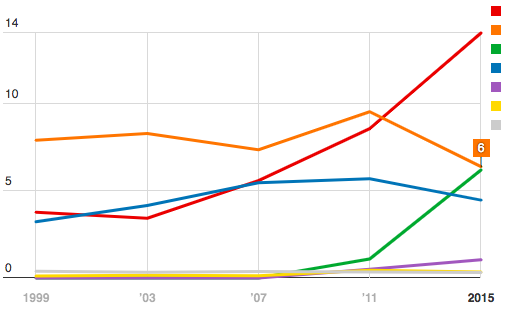At the upcoming NSW state election, we should expect more people than ever before to cast their votes early, while others will use online voting, making ordinary election-day voting a relatively smaller proportion of the total vote.
This story is not entirely unique to New South Wales. In similar democracies all over the world we have seen a rise in people using a greater variety of methods to vote. In particular there has been increased demand to vote early, and electoral administrators have largely tried to keep up with this demand.
I blogged about the trend in how NSW votes shortly after the 2015 election, and I’ll replicate this chart from that post:
The proportion of voters using ordinary election-day voting declined gradually from 1999 to 2007, but then fell precipitously in 2011 and 2015, with just over 67% of votes cast using the ordinary method in 2015.
The above chart shows where those voters have gone. The biggest increase has been in pre-poll voting, which has increased from 3.4% in 2003 to 14% in 2015. I expect we’ll see a further increase in 2019. Pre-poll voting made up about a quarter of votes cast at the 2014 Victorian state election, but this increased to almost 37% in 2018, with less than half of all votes cast as ordinary election-day votes.
The other big change was the rise of iVote, which made up 1% of votes in 2011 and then 6% in 2015. There had been an increase in absent votes in 2011 but that was blunted in 2015, with many of these voters likely switching to iVote or pre-poll.
iVote has been a controversial voting method, with certain computing experts being very critical of the system. I think of the problems with iVote as falling into two camps: very fixable teething and design problems, and fundamental computer security problems.
I’m not going to claim expertise in the deeper security issues, except to note that we should compare iVote to what it is replacing, not to the ideal method of voting. Postal voting is far from an ideal voting method, and particularly does not work for many voters who are overseas.
iVote had some embarrassing problems, with two parties missing their above-the-line box for the first 36 hours of voting. We also know that the first four parties on the Legislative Council ballot performed much more strongly on iVote than other types of voting, because the iVote ballot only showed the left hand side of the ballot and required sideways scrolling.
Since 2015, there has been a wholesale overhaul of the iVote technology, and a security review which made a number of recommendations.
I understand that there have been changed to the ballot design to avoid the large advantage to the left-hand parties – voters will first be shown the whole ballot zoomed out before zooming into a random point on the ballot. I do still wonder whether iVote should consider a different ballot design – if you were designing a ballot for online from scratch you would probably do it differently.
I tend to think internet voting does have value. Postal voting is a pretty poor way of voting, lacking in privacy and reliability, and internet voting is an improvement on that process, particularly for those who are having to mail their ballots from overseas. But it is inferior to voting at a polling station (whether it’s pre-poll or election day, paper or electronic) and it’s important that we don’t let internet voting become the dominant method. I’m concerned by the number of people I’ve seen saying “just say you’ll be interstate on election day, vote online, easy”. I’m not sure what the answer is to that problem, but we need to grapple with it.




Thanks Ben. This is an interesting sub-plot to elections now, particularly wrt the old-fashioned emphasis on election day manning the booths, handing out etc. and all the resources and admin behind this becoming a bit less important than they once were. Many people I’ve spoken to involved with campaigns on all sides are expecting a huge rise in pre-poll, which also changes the timing and thinking around big announcements and campaign stunts.
Can you (Ben) or any of the armchair psephologists on here enlighten me on exactly when pre-poll results are counted and reported i.e. do we get a big chunk of results available at the start of election night coverage or do we have to wait? I haven’t sat and watched election night TV coverage for a while…
Pre-poll votes are counted on the night but usually come in later on in the evening.
Comments are closed.